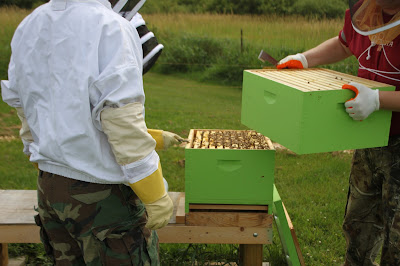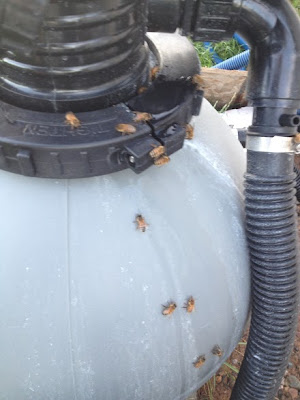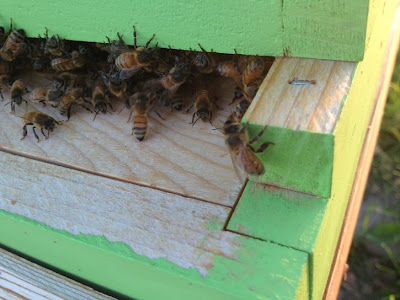Last weekend we built a Solar Wax Melter. We built it so we could melt wax that we collect from uncapping and use it for things. It can be used to make candles, chapstick, and soap.
Here are 66 more uses for beeswax (from http://matteroftrust.org/5044/101-uses-for-beeswax)
1) lubricant for very old furniture joints.
2) Smooth movement for doors and windows.
3) Prevents bronze items from tarnishing.
4) Use as a rust prevention.
5) Furniture polish when mixed with linseed oil and mineral spirits in equal parts.
6) Covering cheeses and preservatives to protect from spoilage.
7) Conditioner for wood bowls and cutting boards.
8) Coat nails and screws to prevent wood from splintering.
9) Used by NASA with an enzyme to mop up oceanic oil spills. - In case you have an ocean and an oil spill
10) Coat reeds for woodwinds to get a tight fit.
11) Egg painting in a Ukraine folk art of Pysanky.
12) An essential ingredient in Indian art of fabric dyeing called Batik printing.
13) Candles that don’t drip and have no smoke.
14) In candy like gummy bears, worms and jelly beans.
15) To water proof leather.
16) Molten beeswax to polish granite counter tops.
17) To make crayons.
18) With palm oil for soap. The palm oil reduces scars and the wax a natural moisturizer.
19) Mix with palm wax for a natural hair remover.
20) To reduce bow string friction.
21) on whips to water proof.
22) Wire pulling.
23) Sewing to strengthen the thread and prevent snagging.
24) To fill seams between pieces of slate when setting up a pool table.
25) As a flexible mold for a variety of mediums.
26) Clean your clothes Iron.
27) In glass Etching.
28) To make earplugs.
29) To make Dental floss.
30) For cracked animal hooves.
31) When making cosmetics.
32) When making chocolates.
33) Removing previous waxes.
34) In Blacksmithing.
35) To coat Baking pans for smooth exit of goods.
36) To make balms.
37) Barbeque preparation.
38) When making healing salves, creams and ointments.
39) Use in pharmaceuticals.
40) As a polish for shoes and floors.
41) To unsticking drawers.
42) Keep zippers moving smoothly.
43) To water proof boots and saddles.
44) To coat hand tools to prevent rust.
45) To relief pain, swelling (inflammation)
46) In fragrances in perfumes.
47) To seal documents.
48) Blended with pine rosin to serve as an adhesive.
49) In the embalming process.
50) As a stabilizer in the military explosive Torpex.
51) A natural Air purifier.
52) Glazing of fruits and vegetables.
53) Chewing beeswax can help quit the habit of smoking.
54) In the restoration of pictures.
55) Wax fly fishing lines so they float.
56) To keep saws sharp.
57) Grinding and polishing of optical lenses.
58) To seal and polish smoke fired pottery.
59) Used on snow skies for a good glide.
60) Used for base ring for toilets (in the past).
61) Saturate cardboard with beeswax and use as a fuel for a backpackers fuel for stove.
62) Beeswax candle as emergency heat when trapped in a car or small space.
63) Temporary filling until you can see your dentist.
64) To seal stick matches to stay dry when boating, fishing or skiing.
65) To prevent slippage for belts in vacuums and sewing machines.
66) As a wood filler
We built our melter out of two old screen door windows we had sitting around and some scrap wood. We also spray painted the inside black to make it heat up faster. It took most of the weekend to build because it was really hot and humid out. We also were trying to use plans from the Internet and then we gave up and just started building.
 |
| Finished Solar Wax Melter |
 |
| Wax melting |
The wax melts at around 144 degrees F and gets discolored if you go above 185 degrees F. Beeswax is very flammable. Here are three one ounce molds we made.
























































